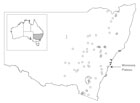
A tree at the Australian National Botanic Gardens in Canberra [©Rick Fencl, 2017.11.24].

Foliage of a tree at the Australian National Botanic Gardens in Canberra [©Rick Fencl, 2017.11.24].

Trunk and bark of a tree at the Australian National Botanic Gardens in Canberra [©Rick Fencl, 2017.11.24].

Distribution of Callitris endlicheri (Bowman and Harris 1995).

More detailed distribution map showing populations in New South Wales (Mackenzie and Keith 2009).

Conservation Status

Callitris endlicheri
(Parl.) F.M. Bailey 1883
Common names
Black cypress pine (Harden 1990).
Taxonomic notes
Syn: C. calcarata (Silba 1986).
Description
Monoecious evergreen trees with mostly erect, sometimes spreading branches. Bark tough and often deeply furrowed. Leaves dark green, 2-4 mm long. Seed cones solitary or several together on rather slender, usually clustered, fruiting branchlets; ovoid to globose or depressed-globose, 15-20 mm in diameter; columella variable, usually short, deeply 3-lobed or with 3 or 4 separate parts (Harden 1990).
Distribution and Ecology
Australia: Queensland, New South Wales, and Victoria. "Usually found on stony hills or ridges, common, from the plains to the coastal ranges" (Harden 1990). Trees are typically killed by canopy fire and the species regenerates from seed (Mackenzie and Keith 2009). The invasive, non-native Rusa deer (Cervus timorensis) has been implicated as preventing or greatly retarding seedling establishment by browsing on the seedlings, and some populations of the species are now declining or threatened (Mackenzie and Keith 2009).
Hardy to Zone 9 (cold hardiness limit between -6.6°C and -1.1°C) (Bannister and Neuner 2001).
Remarkable Specimens
The largest known specimen is a tree in Beechworth, Victoria, that measures 47.7 cm dbh and is 20.25 m tall with a crown spread of 6.3 m (National Register of Big Trees 2018). The greatest known age is 64 years (Pearson et al. 2011), though it seems likely that substantially greater ages are attainable.
Ethnobotany
This species is logged in small quantities for commercial purposes. Its timber superficially resembles that of the widely-used Callitris columellaris, but is far inferior to that species in terms of decay resistance (Ilic 1995).
Observations
Remarks
Citations
Bailey, F.M. 1883. A Synopsis of the Queensland Flora, Brisbane: James C. Beal. p.497. Available at Google Books, accessed 2012.11.24.
Ilic, Jugo. 1995. Distinguishing white from black cypress pine. Onwood 10. CSIRO. http://www.ffp.csiro.au/publicat/onwood/onwood10.htm#No7, accessed 2002.01.22, now defunct.
Mackenzie, B.D.E. and D.A. Keith. 2009. Adaptive management in practice: conservation of a threatened plant population. Ecological Management & Restoration 10(S1):S129-S135.
National Register of Big Trees. 2018. [Unnamed document]. https://www.nationalregisterofbigtrees.com.au/tree_trivia_details_2018.pdf, accessed 2019.03.26.
Pearson, Stuart, Quan Hua, Kathryn Allen, and David M. J. S. Bowman. 2011. Validating putatively cross-dated Callitris tree-ring chronologies using bomb-pulse radiocarbon analysis. Australian Journal of Botany 59(1):7-17, http://dx.doi.org/10.1071/BT10164.
See also
Farjon (2005) provides a detailed account, with illustrations.





